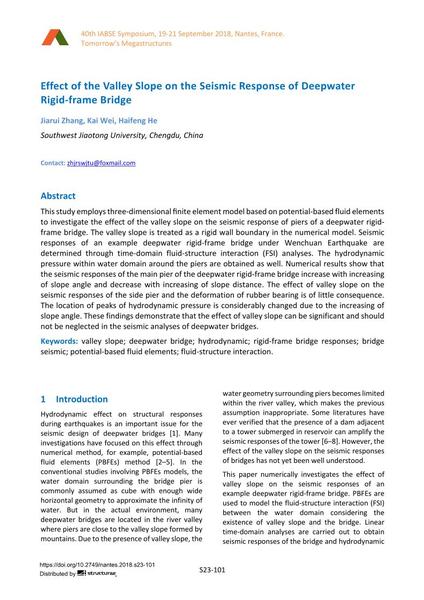Effect of the Valley Slope on the Seismic Response of Deepwater Rigid-frame Bridge

|
|
|||||||||||
Détails bibliographiques
| Auteur(s): |
Jiarui Zhang
(Southwest Jiaotong University, Chengdu, China)
Kai Wei (Southwest Jiaotong University, Chengdu, China) Haifeng He (Southwest Jiaotong University, Chengdu, China) |
||||
|---|---|---|---|---|---|
| Médium: | papier de conférence | ||||
| Langue(s): | anglais | ||||
| Conférence: | IABSE Symposium: Tomorrow’s Megastructures, Nantes, France, 19-21 September 2018 | ||||
| Publié dans: | IABSE Symposium Nantes 2018 | ||||
|
|||||
| Page(s): | S23-101 | ||||
| Nombre total de pages (du PDF): | 8 | ||||
| DOI: | 10.2749/nantes.2018.s23-101 | ||||
| Abstrait: |
This study employs three-dimensional finite element model based on potential-based fluid elements to investigate the effect of the valley slope on the seismic response of piers of a deepwater rigid- frame bridge. The valley slope is treated as a rigid wall boundary in the numerical model. Seismic responses of an example deepwater rigid-frame bridge under Wenchuan Earthquake are determined through time-domain fluid-structure interaction (FSI) analyses. The hydrodynamic pressure within water domain around the piers are obtained as well. Numerical results show that the seismic responses of the main pier of the deepwater rigid-frame bridge increase with increasing of slope angle and decrease with increasing of slope distance. The effect of valley slope on the seismic responses of the side pier and the deformation of rubber bearing is of little consequence. The location of peaks of hydrodynamic pressure is considerably changed due to the increasing of slope angle. These findings demonstrate that the effect of valley slope can be significant and should not be neglected in the seismic analyses of deepwater bridges. |
||||
